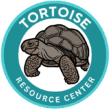One of the trickiest things to nail down as a new sulcata tortoise owner is what to feed them. Even experienced keepers continue researching and fine-tuning their sulcatas’ diets for years because getting nutrition right is absolutely critical for these massive tortoises that can live 80+ years.
Here’s what makes sulcata tortoise food so confusing: the advice you get from pet stores, the internet, and fellow tortoise owners is often contradictory and sometimes dangerously wrong. Some sources tell you vegetables should be the main food. Others say fruit is fine as a regular treat. Many completely misunderstand how different sulcatas are from other popular pet tortoises like Russians or Hermann’s. Following the wrong advice doesn’t just inconvenience your tortoise—it causes permanent shell deformities, kidney failure, and a drastically shortened lifespan.
That’s why I created the Tortoise Resource Center – I wanted better nutritional products for tortoises than what I could find online and in stores. We created the best commercially available feeds – the same products used by zoos and rescues!
The problem is that sulcatas have incredibly specific nutritional requirements based on their native habitat—the driest parts of Africa where the only reliable food sources are grasses and tough shrubbery. Their digestive systems evolved over millions of years to process high-fiber, low-protein, low-moisture vegetation. Feed them like you’d feed a forest tortoise or box turtle, and you’re asking their bodies to handle foods they literally cannot process properly.
This guide will walk you through exactly what sulcata tortoises should eat, what foods cause serious problems, and how to create a feeding routine that keeps your tortoise healthy for decades. You’ll learn why grass-based diets are non-negotiable, which vegetables are actually appropriate, and why that fruit your sulcata loves so much is actually harming them.
- Why Sulcata Tortoise Food Requirements Are Unique
- The Foundation: Grass and Hay (75-90% of Diet)
- Flowers and Leaves: Nature's Treats
- Fruit: Almost Never (Rare Treats Only)
- Vegetables: Use Sparingly (5-10% Maximum)
- Essential Vitamins and Minerals
- Health Problems from Poor Diet
- How and When to Feed Your Sulcata
- Creating Long-Term Feeding Success
- Citations
Why Sulcata Tortoise Food Requirements Are Unique
Before diving into specific foods, you need to understand why sulcatas are so different from other tortoises. These gentle giants are native to the southern Sahara and Sahel region—some of the driest, harshest environments on Earth. In the wild, they spend their days slowly walking and constantly grazing on whatever sparse vegetation they encounter.
The sulcata’s digestive system is specifically adapted to this arid grassland diet. They have specialized gut bacteria that break down tough cellulose from grasses and extract maximum nutrition from plants that seem nearly inedible. Their slow metabolism allows them to survive on low-nutrient, high-fiber foods that would starve other animals. Their kidneys are adapted to process minimal protein—excess protein causes uric acid buildup and kidney failure.
This is completely different from forest tortoises like red-foots that evolved eating varied vegetation including fruits and occasional protein. It’s different from Mediterranean tortoises that have seasonal dietary variations. When you feed a sulcata like these other species, their digestive system can’t properly handle the food. High-protein diets overwhelm their kidneys. Excessive sugars from fruits damage their gut bacteria. Low-fiber foods don’t provide the bulk their intestines need.
The average adult sulcata measures about 18 inches long, though some reach 30 inches. They weigh anywhere from 70 to over 100 pounds. Despite their massive size, their metabolism is incredibly slow—they’re adapted to the low-nutrient foods available in their native habitat. This means they need lots of volume but relatively few calories, and the calories they do consume must come from appropriate sources.
The Foundation: Grass and Hay (75-90% of Diet)
Fresh grass and dry hay should make up 75-90% of your sulcata tortoise’s regular diet. This isn’t a suggestion—it’s a requirement for long-term health. These foods are most similar to what they’d eat in their native African habitat.
Grass and hay are ideal for sulcatas because they’re high in fiber (essential for digestive health), low in moisture (matching their arid native environment), and low in protein (their kidneys can’t handle excess). Most grasses are also fairly low in oxalic acid, which can cause calcium absorption problems when consumed in large amounts.
Grass and Hay
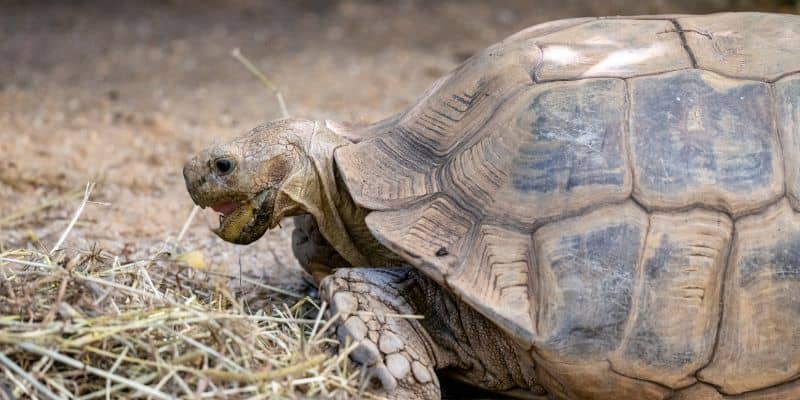
Recommended grasses include: Timothy grass is widely available and offers excellent fiber with low protein. Barley grass provides good nutritional balance. Meadow grass is naturally appropriate for grazing tortoises. Oat grass adds variety to the diet. Orchard grass is slightly softer than timothy and well-accepted by most sulcatas.
Lawn grasses that work well: Many healthy sulcatas feed on their owners’ regular turf grass, which is convenient and cost-effective. Bermuda grass performs well in hot climates and provides good fiber content. St. Augustine grass is another warm-climate option. Just ensure your lawn is completely free of pesticides, herbicides, fertilizers, and any chemical treatments. What seems harmless to humans can be toxic to tortoises.
What about alfalfa? While alfalfa is easy to find in pet stores, it’s not the best option for sulcatas because of its high protein and calcium content. It can be beneficial for juveniles in very small amounts but should be offered sparingly or avoided entirely for adults. Too much alfalfa causes kidney stress and abnormal rapid growth.
Hay preparation: Dried hay should always be available. Soak it briefly in water if your sulcata has difficulty eating very dry hay, though most adults handle it fine. Fresh grass is ideal when available, but quality hay provides excellent nutrition and fiber when fresh options aren’t accessible.
For growing sulcatas, ensuring proper nutrition from grass-based diets is critical. Our Baby Sulcata Superfood Powder is specifically formulated to complement grass-based diets for young tortoises, providing optimal protein-to-fiber ratios with appropriate calcium levels that support healthy growth without the risks of overfeeding or nutritional imbalances.
Flowers and Leaves: Nature’s Treats
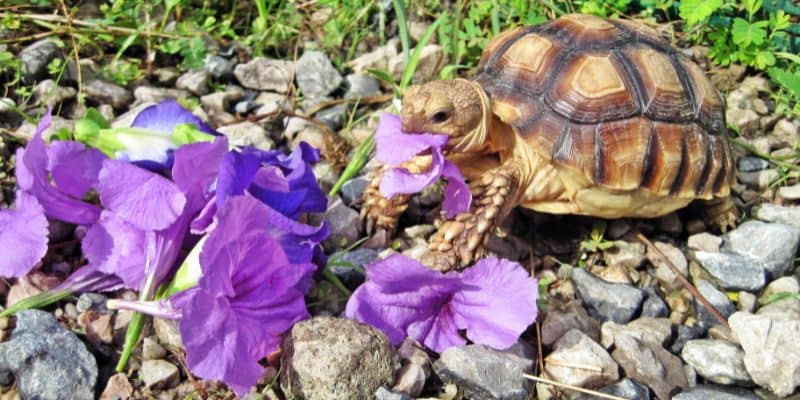
Sulcata tortoises are enthusiastic gardeners—the flowers just don’t survive long! Edible flowers and leaves add variety and enrichment to the diet while providing valuable nutrients and antioxidants.
Safe flowers: Hibiscus flowers and leaves are both popular treats that sulcatas love. Rose flowers (petals) are safe and delicious—ensure they’re pesticide-free. Dandelion flowers are nutrient-rich and typically safe if picked from chemical-free areas. Nasturtium flowers and leaves are high in vitamin C. Violets are safe and enjoyed by most tortoises.
Safe leaves and weeds: Dandelions (entire plant including leaves) are calcium powerhouses. Chickweed is safe in moderation. Plantain (the weed, not the fruit) is nutrient-rich. Some ornamental shrubs and trees have tortoise-safe leaves, but always cross-reference against toxic plant lists before offering.
Important safety notes: Any flowers or leaves fed to your tortoise must be completely free of pesticides, herbicides, fungicides, or any chemical treatments. Even organic pest control products can be harmful. If you’re unsure whether a plant is safe, don’t feed it. When in doubt, stick to the confirmed safe options or consult a reptile veterinarian.
Flowers and leaves should supplement the grass-based diet, not replace it. Think of these as enrichment and nutritional bonuses, not staple foods.
Fruit: Almost Never (Rare Treats Only)
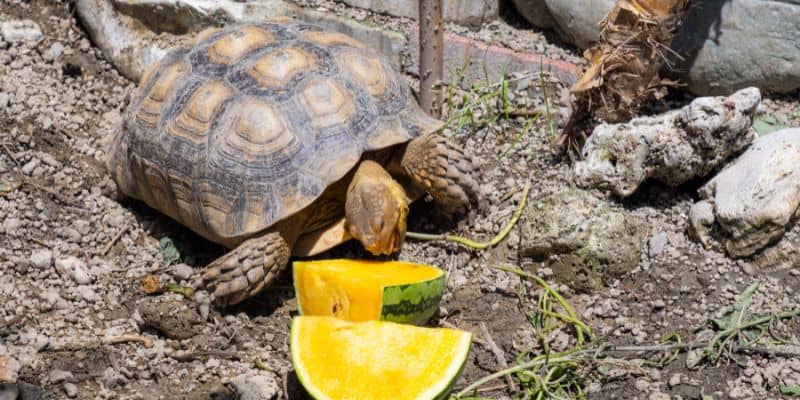
Here’s where I need to be very direct: sulcata tortoises should rarely if ever eat fruit. I know they absolutely love it. I know it seems harmless. But fruit causes serious problems in sulcatas that don’t show up immediately, making it easy to underestimate the damage you’re causing.
Fruit is extremely high in sugar and water compared to what sulcatas naturally eat. Just like humans can’t survive on candy and pastries, your tortoise can’t thrive on fruit. But it’s actually worse for sulcatas than that analogy suggests.
Grazing tortoises like sulcatas are particularly sensitive to fruit because of their unique digestive systems. They have specialized gut bacteria adapted to process tough, fibrous grasses. High-sugar foods like fruit damage these beneficial bacteria, interfering with digestion and potentially causing toxic shock syndrome. While forest tortoises like red-foots might handle fruit once or twice weekly, most experts agree that sulcatas shouldn’t eat fruit at all.
Vegetables: Use Sparingly (5-10% Maximum)
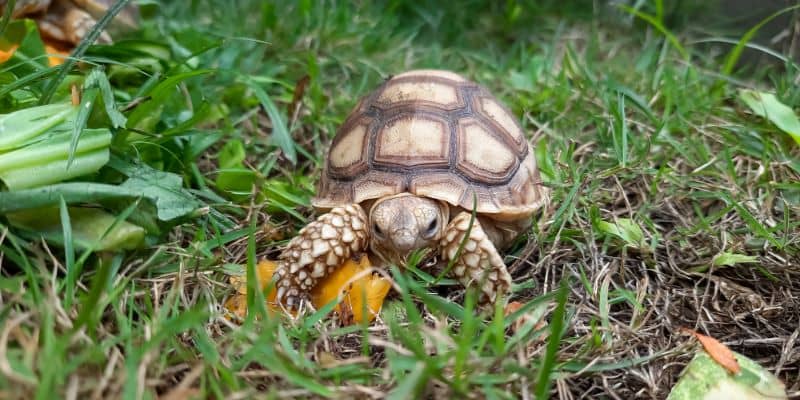
Vegetables shouldn’t be the bulk of a sulcata’s diet despite what many pet stores suggest. If fruit is candy, then vegetables are like pizza—fine in moderation but not something to build a diet around.
Remember when I said grass and hay should be 75-90% of the diet? Vegetables should make up only 5-10% of total food intake. They’re supplements that add variety and certain nutrients, not primary foods.
Appropriate vegetables in small amounts: Shredded carrots provide beta-carotene beneficial for shell and skin health. Squash (butternut, acorn, yellow) can be fed raw or cooked. Corn should be offered very sparingly if at all—it’s high in phosphorus and sugar. Dandelion greens are actually excellent and can be fed more liberally than other vegetables. Lettuce has minimal nutritional value but won’t harm in small amounts. Cabbage should be limited—it contains goitrogens affecting thyroid function.
Important distinction: Many new tortoise owners confuse grasses with leafy greens like dandelion greens, lettuce, kale, and turnip greens. While this might all seem like similar plant matter, leafy greens contain significantly more protein than fresh grass or dry hay. Feeding too many leafy greens can impact growth and overall health over time because sulcatas can’t handle high protein levels.
Feeding frequency for vegetables: Offer small amounts of appropriate vegetables 2-3 times weekly maximum. They should never make up the majority of any meal. Always prioritize grass and hay, using vegetables as minor supplements only.
Are You Starving Your Tortoise?
Save 10% on premium tortoise food and supplements from Tortoise Resource Center on Amazon now using code BUYNOWGET10

Sulcata Vitamin & Mineral Topper Supplement
30-Day Supply | 2 oz (56 g)
$24.99
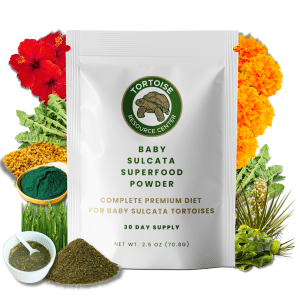
Baby Sulcata Tortoise Superfood Powder
30-Day Supply | 2.5 oz (70.8 g) Bag
$24.99
Essential Vitamins and Minerals
Key vitamins and minerals need to be supplemented even with excellent base diets. Of all supplements, calcium is by far the most important for overall health. Too little calcium results in poor bone and shell development, soft shells, and metabolic bone disease.
The Chicago Exotics Animal Hospital recommends high-quality calcium supplements that are free of phosphorus for sulcata tortoises. This is because sulcatas get plenty of bioavailable phosphorus from their plant-based diets, and too much phosphorus interferes with calcium absorption. The ideal calcium-to-phosphorus ratio is 2:1 to 3:1—meaning two to three times as much calcium as phosphorus.
Most sulcatas also benefit from comprehensive vitamin and mineral supplementation. Our Vitamin and Mineral Topper provides balanced minerals and vitamins specifically formulated for desert tortoise species, ensuring complete nutrition even when diet variety is limited.
Supplementation schedule: Dust food with calcium powder at every feeding for juveniles (daily feeding), or 5-6 times weekly. Adults need calcium supplementation 2-3 times weekly. Add comprehensive vitamin/mineral supplements 1-2 times weekly. The exact schedule varies based on diet composition, UVB exposure, and individual needs, so work with a reptile veterinarian to fine-tune your tortoise’s supplementation routine.
Vitamin D3 considerations: Sulcatas synthesize vitamin D3 through UVB exposure, which is essential for calcium absorption. Outdoor tortoises with natural sunlight typically need less vitamin D3 supplementation than indoor tortoises relying on artificial UVB lighting. Over-supplementing vitamin D3 can cause toxicity, so use products with D3 carefully and follow dosage recommendations.
Foods That Will Harm Your Sulcata
Some foods are dangerous for sulcatas and must be completely avoided. Understanding what not to feed is just as important as knowing appropriate foods.
Never feed meat or dairy: Sulcata tortoises require very low-protein diets. Meat and dairy contain far too much protein for their systems to safely process. These foods cause uric acid buildup, kidney damage, and organ failure.
Absolutely no pet food: Some people mistakenly try feeding tortoises dog or cat kibble. This is extremely dangerous due to inappropriate protein levels, wrong nutrient ratios, and ingredients tortoises cannot digest. Never feed any pet food designed for carnivorous or omnivorous animals.
Avoid high-protein vegetables: Not all vegetables are safe for sulcatas. Completely avoid beans, peas, and their byproducts—these are naturally packed with protein that sulcatas can’t handle. Soybeans and soy products are particularly problematic.
No grains or seeds: Grains like wheat, barley, oats, and corn are fairly high in protein. Sulcatas can eat the grass leaves from these crops but should never be fed the seeds or grain products. This includes bread, cereals, crackers, or any grain-based processed foods.
Toxic plants: Completely avoid avocado (contains persin, highly toxic), rhubarb (causes kidney damage), tomato plants (green parts contain solanine), potato plants (especially green parts and sprouts), onions, garlic, and chives (cause anemia). Many ornamental plants are also toxic—always verify safety before allowing access.
Health Problems from Poor Diet
Poor diet contributes to most health issues in captive sulcata tortoises. Understanding these problems helps you appreciate why appropriate sulcata tortoise food choices matter so much.
Improper growth and pyramiding: A diet too high in protein or general overfeeding causes rapid growth in young tortoises. This leads to shell deformities like bumps or pyramiding—where scutes grow upward in pyramid shapes instead of remaining flat. In extreme cases, these permanent deformities impact health, quality of life, and lifespan.
Uric acid buildup: High-protein diets cause uric acid buildup. Uric acid is a natural byproduct of metabolizing protein, normally flushed by the kidneys. When sulcatas eat too much protein, uric acid crystals build up in the bladder and other organs. According to the Merck Veterinary Manual, this can cause gout affecting joints or heart, leading to pain, reduced mobility, and organ damage.
Calcium deficiency: Feeding too little calcium causes serious issues like shell softening and metabolic bone disease. This also occurs when diets are too high in phosphorus (which interferes with calcium absorption) or when tortoises lack adequate UVB exposure (preventing vitamin D3 synthesis needed for calcium absorption). A healthy tortoise needs balanced calcium and phosphorus ratios—work with a veterinarian if you notice signs of deficiency.
Oxalate buildup: While most experts advise against high-oxalate foods, grazing tortoises like sulcatas seem less sensitive to oxalates than other species. Their guts are designed to digest tough plants that are naturally high in oxalic acid. However, excessive oxalate consumption can still interfere with calcium absorption and cause kidney stones. Prevent problems by keeping your tortoise well-hydrated and feeding high-oxalate vegetables (spinach, broccoli) only in tiny quantities if at all.
Toxic shock syndrome: Feeding foods high in sugars or acids—fruit is the most common culprit—can damage the beneficial gut bacteria that sulcatas need to digest rough foliage. This interferes with digestion to the point of causing toxic shock syndrome, which can be fatal.
How and When to Feed Your Sulcata
One of the best ways to keep your sulcata healthy is committing to a regular feeding schedule. Here’s how to create sustainable feeding routines.
Feeding frequency for adults: Adult sulcatas should eat at least 3-4 times per week, though daily feeding is also appropriate. These are large grazers naturally adapted to eating throughout the day but also capable of going days without food during harsh weather. There may be times when appetite decreases—this is common in cooler weather—but you should still offer fresh food regularly.
Feeding frequency for juveniles: Young tortoises under one year old can and should eat daily. They’re growing rapidly and need consistent nutrition to develop properly. As they approach 12-18 months, you can begin transitioning to the adult schedule of 3-4 times weekly or continue daily feeding depending on individual needs.
Provide tons of variety: Sulcatas can be selective eaters. For a well-rounded diet and enrichment, mix together 2-3 different grasses, hays, or appropriate foods for each meal. This prevents boredom, ensures varied nutrition, and keeps your tortoise engaged with feeding.
Supplement consistently: Add calcium powder to every meal for juveniles, or 5-6 times weekly for growing tortoises. Adults need calcium supplementation 2-3 times weekly. Add comprehensive vitamin and mineral supplements 1-2 times weekly as needed based on your veterinarian’s recommendations.
Mimic natural behaviors: Rather than pile all food in one location, scatter it around the enclosure to encourage natural foraging and movement. This promotes exercise, mental stimulation, and healthier eating patterns compared to “bowl feeding.”
Creating Long-Term Feeding Success
Proper sulcata tortoise food choices today set the foundation for 80+ years of health. The diet you provide determines whether your sulcata develops strong bones and proper shell formation or suffers from deformities and organ damage. It determines whether they live a full lifespan or succumb to preventable kidney failure in their 20s or 30s.
The good news is that once you understand sulcata nutritional requirements, feeding appropriately becomes straightforward. Focus on grass-based diets with appropriate calcium supplementation. Avoid the temptation to feed them like omnivorous pets. Resist offering fruit despite how much they seem to enjoy it. Use vegetables sparingly as supplements, not main foods.
Want comprehensive guidance on perfecting your sulcata’s diet for every life stage? Sign up for our free bonus pack and get instant access to detailed meal plans, feeding schedules by age, troubleshooting guides for picky eaters, and complete food safety lists. Plus you’ll receive growth tracking charts, exclusive discount codes, and expert tips for raising healthy sulcatas from hatchling to giant adult.
Your sulcata is counting on you to provide the nutrition they need to thrive for decades. With the right knowledge and consistent application of proper feeding principles, you can give them exactly that—a long, healthy life built on the foundation of appropriate sulcata tortoise food choices made every single day.
Citations
Merck Veterinary Manual – Metabolic and endocrine diseases of reptiles Avian & Exotic Animal Hospital of Louisiana – Sulcata tortoise care sheet MedVet – Sulcata tortoise background and care recommendations Chicago Exotics Animal Hospital – Diet for sulcata tortoises
